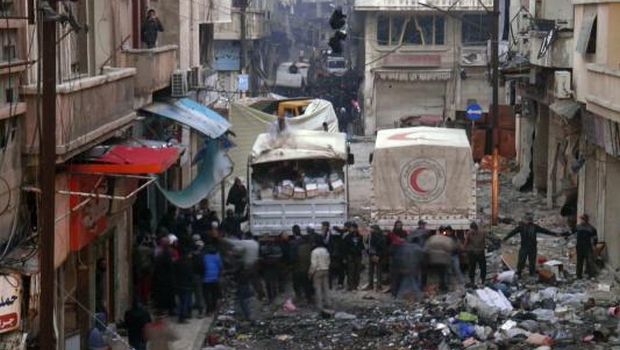
Syrian Arab Red Crescent trucks stand in the besieged neighborhoods of Homs to supply humanitarian aid (REUTERS/Thaer Al Khalidiya)
Talal Barrazi, the governor of Homs province, told the Lebanon-based Al-Mayadeen TV that the attack occurred late in the afternoon and that the trucks were targeted by two roadside bombs and a mortar shell from the rebel side.
Homs activist Ahmad Al-Qusair however denied there had been roadside bombs and said the convoy was attacked by mortar shells fired by government forces.
Barrazi later told Syrian state TV that two trucks were able to reach opposition-held neighborhoods earlier in the day.
Al-Mayadeen also reported that two trucks, carrying 250 food parcels, were able to cross into rebel-held areas Saturday.
The state TV said four members of the Syrian Arab Red Crescent were wounded by rebel fire in the area, but gave no further details.
The Syrian Arab Red Crescent said on its Facebook page that its members were able to deliver 250 food parcels and 190 parcels containing detergents and medicines to the central neighborhood of Hamidiyeh despite begin targeted by several mortar rounds. It added that one of its members was lightly wounded and two trucks were damaged.
It was not immediately clear why state media said four paramedics were wounded and the Red Crescent said only one.
Barrazi said about 100 civilians expected to be evacuated from rebel-held areas had yet to arrive. On Friday, 83 children, women and elderly people on wheelchairs were evacuated from Homs, the first people to leave the area in months, the UN said.
Syrian forces loyal to President Bashar Assad have prevented the entry of food and medical aid into rebel-held parts of the city for over a year, badly affecting hundreds of civilians holed up in the areas. An agreement had called for a three-day truce to allow the evacuation of some civilians and the entry of food shipments.
Al-Mayadeen aired live footage from the city’s Clock Square showing two white trucks identified with Syrian Arab Red Crescent markings as they returned from their unfulfilled mission. The station’s reporter in the area said the radiator of one of the trucks was hit by a bullet.
“After the vehicles drove about 200 meters, two roadside bombs went off, and when they kept going a mortar round fell in the area coming from the direction of Hamadiyeh,” said Barrazi, referring to a rebel-held central neighborhood.
Earlier in the day, a Syrian official said fighting had broken out and that a mortar shell had landed near UN personnel. An activist said combat began when government forces fired 11 rockets toward the rebel-held Hamidiyeh quarter. The official spoke on condition of anonymity because he was not authorized to brief reporters.
UN humanitarian chief Valerie Amos said in a statement Saturday evening that she was disappointed the three-day humanitarian pause was broken and that aid workers were targeted.
“Today’s events serve as a stark reminder of the dangers that civilians and aid workers face every day across Syria,” the statement read. “I continue to call on those engaged in this brutal conflict to respect the humanitarian pause, ensure the protection of civilians and facilitate the safe delivery of aid.”
The Britain-based Syrian Observatory for Human Rights said two people were killed and several others wounded in an attack on rebel-held neighborhoods that residents blamed on government forces.
Homs city was one of the first areas to rise up against Assad in 2011 and has been particularly hard hit by the war. Over the past year, the government has regained control over much of the city, except for a few neighborhoods in the historic center.
A coalition of exiled Syrian activists said Saturday they feared the agreement would be used as a “prelude to the regime destroying the city.”
“It has used similar deals to buy time to strengthen its positions on the ground and to kill more civilians,” the Syrian National Coalition said.
Video footage from Homs showed UN SUV’s in a street full of debris as gunfire rang out. The videos posted online by activists showed wounded men being rushed away from the scene. They appeared genuine and corresponded to other Associated Press reporting of events.
The Observatory and Syrian state TV reported that a Libyan commander of the Al-Qaeda-breakaway group the Islamic State of Iraq and Syria was killed in fighting with a rival rebel group in the eastern province of Deir El-Zour. The TV identified him as Abu Dajana Al-Libi.
Hundreds of fighters from the opposition and the Islamic State have died in battles between opposing rebel groups since the beginning of the year.
Also Saturday, Syria’s Foreign Minister said Damascus is preparing to transport “a large amount” of chemical agents in order to be shipped outside the country. It added that Syria is determined to end this “process as soon as possible.”
The ministry’s statement came two days after the UN Security Council called on Syria to speed up the removal of its most harmful chemical weapons agents from the country, expressing “growing concern” at several missed deadlines.
The Syrian government missed a Dec 31 deadline to remove the most dangerous chemicals in its stockpile from the war-torn country and Wednesday’s deadline to give up its entire stockpile of chemical weapons. Assad’s government has cited security concerns and the lack of some equipment but says it remains fully committed to the process.
In Beirut, airport officials said Sigrid Kaag, head of the mission charged with destroying Syria’s chemical weapons, arrived in Lebanon Saturday night and was expected to drive to the Syrian capital the next day. They spoke on condition of anonymity in line with regulations.
